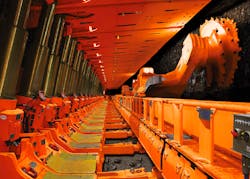Manufacturing Integration and Intelligence (MII) was a hot topic during the SAP Manufacturing Industry Forum 2014. It is SAP software that connects the shop floor to business operations, and several users sung its praises during the two-day conference last week in Itasca, Ill.
One such user is Joy Global, a $5 billion company that makes mining equipment. In a relationship with SAP that goes back to 1992, Joy Global is now piloting and beginning to roll out MII in its operations.
Not only does MII provide business analytics for operations, it also links engineering to manufacturing, giving engineering “the ability to see the heartbeat of manufacturing,” says Tim Bartel, global IT director for Joy Global.
One-and-a-half years ago, Joy Global implemented systems to capture data on the factory floor. They could also pull information from the ERP system and tie that back to the floor. “It provides real-time information that the operator can use, and also the operations VP,” Bartel says.
Before beginning use of SAP’s MII product, Joy Global could analyze product metrics only after the fact, Bartel says. “It made it difficult to make any type of change,” he says. “It was also hard to see the root cause.”
Much of the productivity improvement was done through trial and error, often just working on someone’s best guess of what a problem might be. “Now we’re in a much better place to diagnose and make improvements,” Bartel says.
Joy Global has 132 locations in about 20 countries, serving customers of all sizes. It started the MII project in a relatively small pilot plant in order to minimize issues.
The plant has so far seen a greater than 10 percent improvement in productivity. The key has been greater visibility into operations. For example, team members can see when an order is supposed to be completed, and can also see if there are any risks of not making that deadline—a machine is down, materials are not available, etc. They can make necessary adjustments to the schedule or can expedite materials, Bartel explains. It might even be that the delivery prediction was bad to begin with, and through the increased visibility predictions can be more accurate going forward, he adds.
Part of this project has included efforts to remove and reduce paper in the manufacturing process. The paperless work cell has been more efficient and more flexible, Bartel says. “The manufacturing schedule almost always changes,” he explains. “Now we can pull that information on the fly.”
Previously, operators would work with a stack of shop papers. They would start with the top paper, working their way down. If they didn’t have the right materials for a job, or there was some other reason they couldn’t do it, that paper would be set aside and they’d grab the next paper in the stack. With the paperless work cell, Joy Global has the flexibility to adjust the workflow during the day, making production more efficient and more able to meet customer needs, Bartel says.
Even considering some very old machines in the operations that are not able to be networked (necessitating manual input of some data into the system), the technology change was only part of the story. Bartel figures that the cultural change accounted for about half of the effort, presenting a “pretty big obstacle.”
One issue was that some workers are uncomfortable with the increased visibility into the process. “Certainly you will always have some labor you can make more productive,” Bartel concedes. “But there are also process and system issues you can now address.”
Change management messaging from the company’s leaders has been very important, Bartel says. That has been reinforced throughout the process and through training. “Change management is by far the biggest obstacle that we’ve seen,” he adds.
Bartel emphasizes that it was important to begin the rollout with a pilot plant in order to work through any kinks. Not only was the pilot plant small, making it more manageable, it had good change management, along with an experienced IT and plant team. The plant manager was also very engaged and tech-savvy, Bartel adds.
The Pennsylvania plant was close to technology, Bartel notes. It’s close to a data center, with plenty of IT people available. “We still have to have a very good, robuts network; we want it to be responsive,” he says. “This made it very easy for the solution to be successful.”
Despite the success of the pilot, Bartel expects the second rollout to still take considerable work, requiring more funding and technologies. “No line is the same; every one has nuances,” he says. “We can’t roll out that fast.” So far, though, all feedback has been positive, he notes.
About the Author
Aaron Hand
Editor-in-Chief, ProFood World

Leaders relevant to this article:
